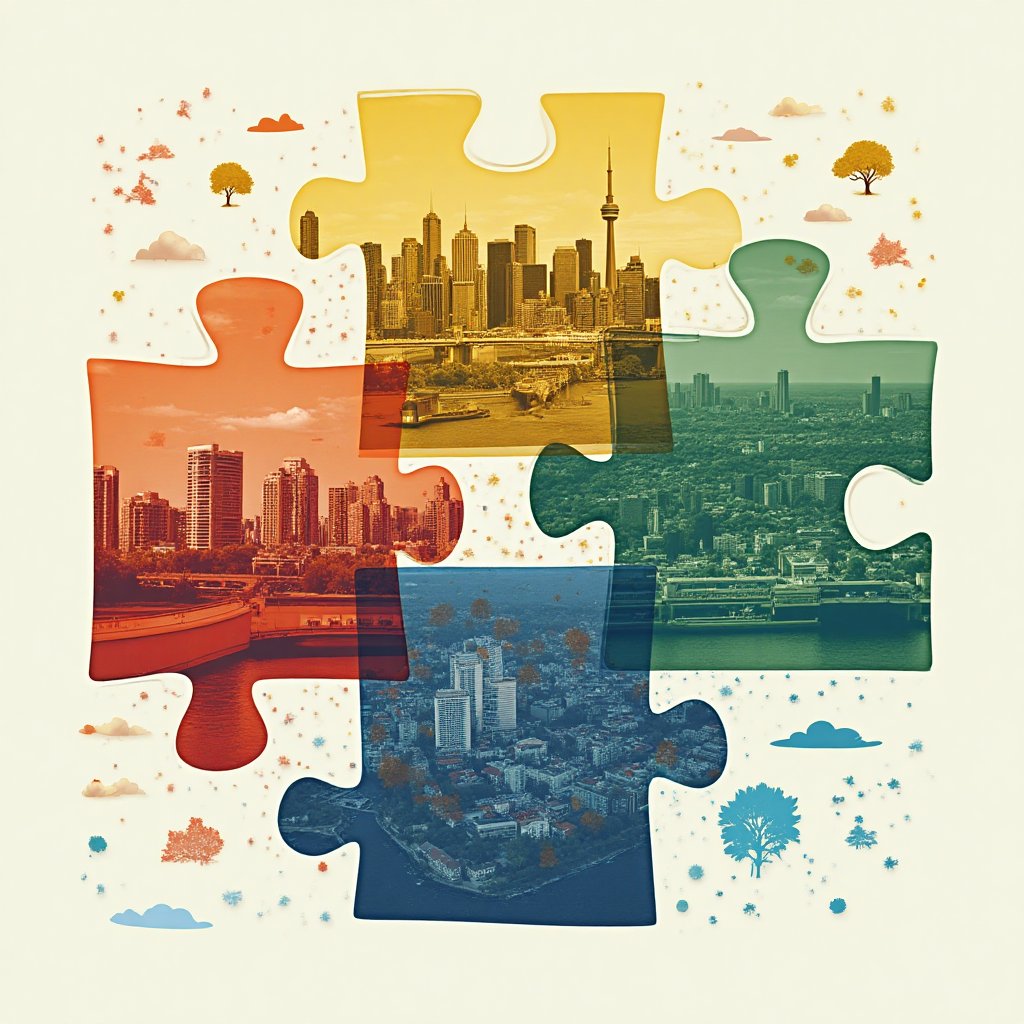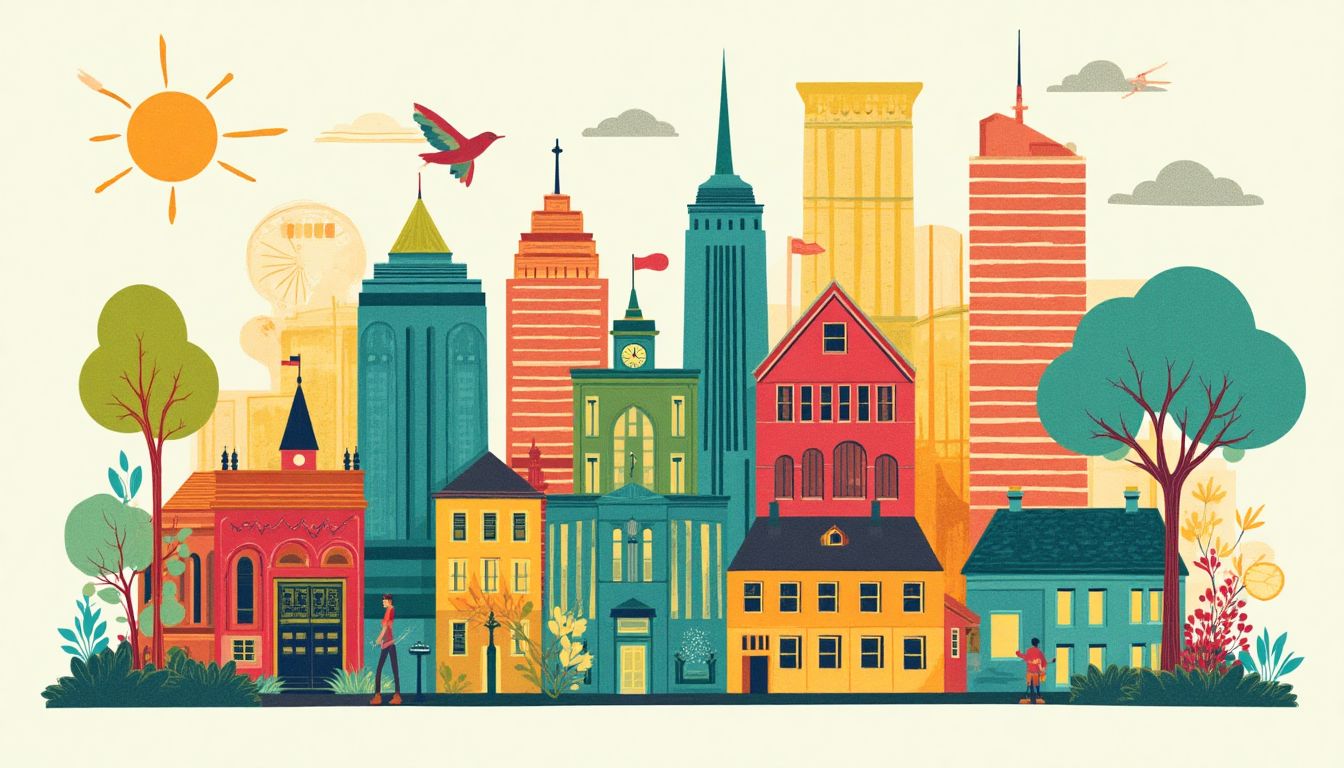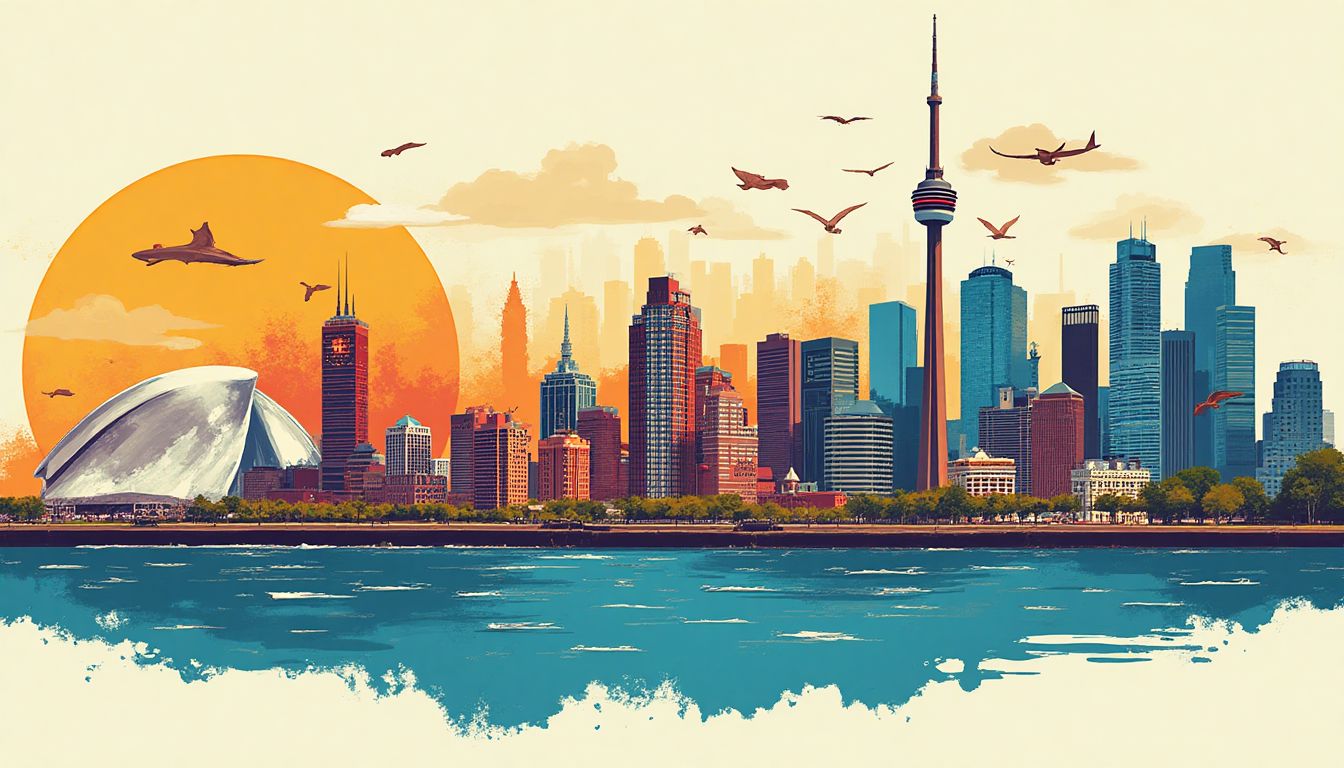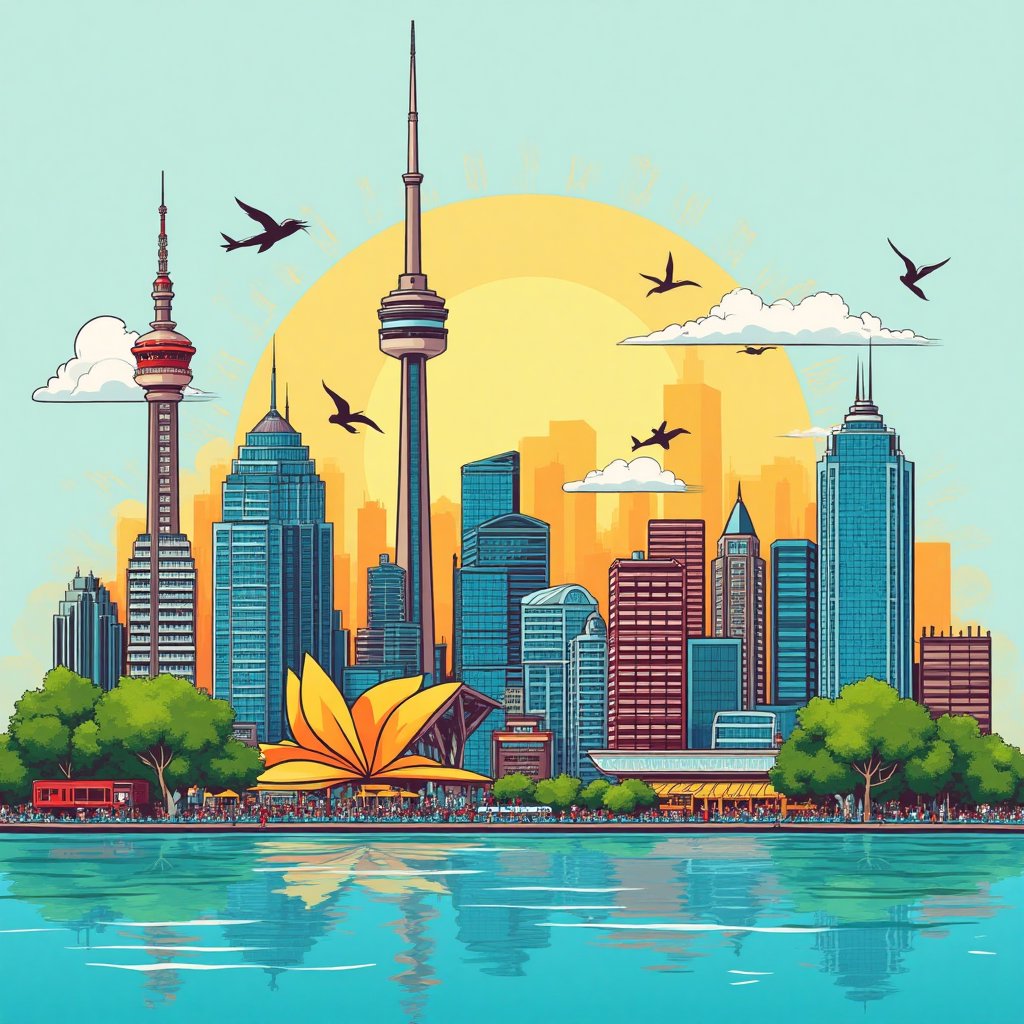Toronto, Canada’s bustling metropolis, is often celebrated for its towering skyscrapers, diverse neighborhoods, and vibrant culture. But here’s a twist: Toronto isn’t just one city—it’s six. Yes, you read that right. Six distinct cities, each with its own story, character, and charm, were stitched together in 1998 to create the Toronto we know today. This amalgamation wasn’t just a bureaucratic reshuffle; it was a bold experiment in urban planning that continues to shape the city’s identity. From the suburban tranquility of Etobicoke to the historic streets of Old Toronto, these six cities are the building blocks of a metropolis that’s as complex as it is captivating. Renowned urbanist Jane Jacobs once described cities as “problems of organized complexity,” and Toronto’s six-city structure is a perfect example of this. Similarly, Richard Florida, a leading urban studies theorist, has praised Toronto’s diversity as a key driver of its economic and cultural success. Even Malcolm Gladwell, in his exploration of urban dynamics, has highlighted how cities like Toronto thrive on their ability to blend the old with the new. So, what are these six cities, and how do they contribute to Toronto’s unique identity? Let’s dive in.
Etobicoke: The Suburban Gem
Nestled in the western part of Toronto, Etobicoke is often described as the city’s suburban gem. Its name, derived from the Mississauga word wadoopikaang, meaning “where the alders grow,” hints at its natural roots. Originally settled in the 1790s, Etobicoke started as a quiet township before evolving into a thriving suburban area. Today, it’s a mix of residential neighborhoods, commercial hubs, and green spaces that offer a slower pace of life compared to the bustling downtown core.
Historical Background
Etobicoke’s history is deeply tied to its agricultural beginnings. In the early 19th century, it was primarily farmland, with settlers drawn to its fertile soil and proximity to Lake Ontario. Over time, as Toronto expanded, Etobicoke transformed into a suburban haven, attracting families looking for a quieter lifestyle. The construction of highways like the Gardiner Expressway in the 1950s further connected it to the city, making it a popular choice for commuters.
Cultural and Economic Contributions
Etobicoke is home to some of Toronto’s most iconic attractions. The Woodbine Racetrack, a premier horse racing venue, draws visitors from across the region. Meanwhile, Sherway Gardens, a sprawling shopping mall, is a retail paradise for locals and tourists alike. The area is also known for its diverse neighborhoods, such as The Kingsway, which boasts tree-lined streets and stately homes, and Mimico, a lakeside community with a small-town feel.
Challenges and Opportunities
Despite its many strengths, Etobicoke faces its share of challenges. Traffic congestion is a growing concern, particularly along major arteries like Dundas Street and Bloor Street. Aging infrastructure also poses issues, with some neighborhoods in need of upgrades. However, these challenges also present opportunities. Future development could focus on improving public transit, expanding green spaces, and fostering economic growth through initiatives like the Etobicoke Mobility Strategy, which aims to create a more connected and sustainable community.
North York: The Urban-Suburban Hybrid
North York is like that friend who can’t decide if they’re a city slicker or a suburbanite. Once a sleepy rural area, it transformed into a bustling urban center in the mid-20th century, earning its city status in 1979 before joining the Toronto amalgamation in 1998. Today, it’s a fascinating mix of skyscrapers, leafy neighborhoods, and everything in between.
Historical Background
North York’s roots go back to the early 19th century when it was primarily farmland. Its transformation began in the 1950s and 1960s, as Toronto’s population boomed and urban sprawl took hold. The construction of the Yonge Street subway line in 1954 was a game-changer, connecting North York to downtown Toronto and fueling its growth. By the 1970s, it was a thriving city in its own right, complete with its own mayor and city council.
Cultural and Economic Contributions
North York is a cultural melting pot, home to diverse communities from around the world. It’s also a hub for education, with institutions like York University and Seneca College attracting students from across the globe. The iconic Ontario Science Centre is a must-visit for science enthusiasts, while Yonge Street offers endless shopping and dining options. And let’s not forget Toronto Zoo, which technically sits on the border of North York and Scarborough but is a beloved attraction for locals and tourists alike.
Challenges and Opportunities
North York’s rapid growth hasn’t come without challenges. Housing affordability is a major issue, with skyrocketing prices pushing many residents out of the market. Traffic congestion is another headache, especially along major arteries like Yonge Street and the 401. But with challenges come opportunities. Future development could focus on sustainable urban planning, such as expanding public transit and creating more affordable housing. Community engagement will also be key to ensuring that North York remains a vibrant and inclusive place to live.
Scarborough: The Multicultural Powerhouse
Scarborough is the kind of place where you can travel the world without ever leaving the city. Known for its incredible diversity, it’s a melting pot of cultures, cuisines, and communities. But Scarborough is more than just a cultural hub—it’s a place with a rich history and a bright future.
Historical Background
Scarborough’s story begins in the late 18th century when it was settled by European immigrants. It was named after the English town of Scarborough, thanks to its scenic bluffs that reminded early settlers of the cliffs back home. Over the years, it grew from a rural township into a bustling borough, officially becoming a city in 1983 before joining the amalgamated Toronto in 1998.
Cultural and Economic Contributions
Scarborough is a cultural powerhouse, with neighborhoods like Agincourt and Malvern showcasing its diversity. It’s also home to some of Toronto’s most iconic attractions, including the Toronto Zoo and the stunning Scarborough Bluffs. Foodies will love exploring the area’s countless restaurants, offering everything from Caribbean jerk chicken to Sri Lankan hoppers. And let’s not forget Scarborough Town Centre, a shopping haven for bargain hunters and fashionistas alike.
Challenges and Opportunities
Despite its many strengths, Scarborough faces its share of challenges. Underfunded infrastructure, particularly in public transit, has long been a concern for residents. Economic opportunities are also unevenly distributed, with some neighborhoods struggling to attract investment. But the future looks bright. Plans for the Scarborough Subway Extension promise to improve connectivity, while initiatives to attract businesses and foster local entrepreneurship could help boost the economy. With the right investments, Scarborough has the potential to become an even greater cultural and economic force in Toronto.
York: The Historic Enclave
York, nestled in the west-central part of Toronto, is a city steeped in history. Its roots trace back to the 19th century, and it was officially incorporated as a city in 1967. Today, York is a blend of historic charm and modern vibrancy, offering a unique glimpse into Toronto’s past while contributing to its present.
Historical Background
York’s history is deeply intertwined with the development of Toronto itself. Originally part of the Township of York, it became a city in its own right in 1967. The area is home to some of Toronto’s oldest neighborhoods, including Weston, which dates back to the early 1800s. Weston’s historic Main Street is a testament to the area’s rich heritage, with buildings that have stood for over a century.
Cultural and Economic Contributions
York is known for its strong sense of community and historic neighborhoods. Weston, for example, is a hub of local culture, with its annual Weston Village Festival drawing crowds from across the city. The area is also home to small businesses that have been family-owned for generations, contributing to its unique character.
- Historic Landmarks: Weston’s historic Main Street, the Humber River, and the Old Mill.
- Community Events: The Weston Village Festival and local farmers’ markets.
- Economic Drivers: Small businesses, local shops, and community initiatives.
Challenges and Opportunities
Like many historic areas, York faces challenges such as urban decay and the need for revitalization. However, these challenges also present opportunities. For example, the redevelopment of the Weston GO Station has brought new life to the area, improving transit access and attracting new businesses. Future plans could focus on preserving York’s historic character while fostering economic growth and community engagement.
East York: The Small but Mighty Borough
East York, the smallest of the six cities, packs a punch with its tight-knit communities and rich history. Incorporated as a borough in 1924, East York has a strong working-class heritage and a reputation for being a close-knit, family-oriented area.
Historical Background
East York’s history is rooted in its working-class origins. It was established as a borough in 1924, making it one of the youngest of the six cities. Despite its small size, East York has played a significant role in Toronto’s development, particularly in the post-war era when it became a hub for returning veterans and their families.
Cultural and Economic Contributions
East York is known for its strong sense of community and green spaces. Taylor Creek Park, for example, is a beloved local landmark that offers residents a place to connect with nature. The East York Civic Centre, with its iconic clock tower, is another symbol of the borough’s pride and identity.
- Green Spaces: Taylor Creek Park, Stan Wadlow Park, and the Don Valley.
- Community Hubs: The East York Civic Centre and local community centers.
- Cultural Events: The East York Canada Day Parade and local festivals.
Challenges and Opportunities
East York faces challenges like limited economic growth and aging infrastructure. However, its small size and strong community spirit make it an ideal candidate for targeted development. For example, initiatives to attract small businesses and improve public spaces could breathe new life into the borough while preserving its unique character.
AI Solutions: How Could AI Tackle This Issue?
Artificial Intelligence (AI) has the potential to revolutionize urban planning and community integration in Toronto’s six cities. By leveraging cutting-edge technology, we can address the unique challenges faced by Etobicoke, North York, Scarborough, York, East York, and Old Toronto while preserving their distinct identities. Here’s how AI can make a difference:
Data-Driven Urban Planning
AI can analyze vast amounts of data on population growth, traffic patterns, and housing needs to create optimized development plans. For example, platforms like Esri’s GIS mapping software can help urban planners visualize and predict trends, ensuring that resources are allocated efficiently.
Smart Infrastructure
AI-powered systems can manage traffic, energy usage, and waste management more efficiently. Companies like Siemens are already implementing smart city solutions that reduce congestion and improve sustainability. Imagine AI-controlled traffic lights that adapt in real-time to reduce gridlock during rush hour.
Community Engagement
AI chatbots and platforms can gather feedback from residents to ensure their needs are met. Tools like CitizenLab enable cities to engage with citizens on critical issues, fostering a sense of ownership and collaboration.
Predictive Analytics
AI can predict future challenges like housing shortages or environmental risks, allowing for proactive solutions. For instance, IBM’s predictive analytics tools can help cities anticipate and mitigate issues before they escalate.
Cultural Preservation
AI can analyze historical data to ensure development respects the unique character of each city. By using machine learning algorithms, cities can identify and preserve culturally significant landmarks and traditions.
Action Schedule/Roadmap
Here’s a detailed roadmap to implement AI-driven solutions across Toronto’s six cities:
- Day 1: Assemble a multidisciplinary team of urban planners, AI experts, data scientists, and community leaders. Partner with institutions like the University of Toronto for research support.
- Day 2: Begin data collection on population, infrastructure, and economic trends using tools like Tableau for visualization.
- Week 1: Develop AI models for traffic and housing analysis, leveraging platforms like TensorFlow.
- Week 2: Launch community engagement platforms to gather resident feedback. Use SurveyMonkey for quick polls and Slack for team collaboration.
- Month 1: Implement AI-powered traffic management systems in high-congestion areas, partnering with companies like Waze.
- Month 2: Begin predictive analytics for housing and environmental risks using SAS analytics software.
- Year 1: Complete initial development plans for each city, incorporating AI insights and community feedback.
- Year 1.5: Launch pilot projects for smart infrastructure, such as AI-controlled public transit systems and energy-efficient buildings.
- Year 2: Evaluate progress and scale successful initiatives across all six cities, ensuring a cohesive and sustainable urban future.
Building a Brighter Future for Toronto’s Six Cities
Toronto’s six cities—Etobicoke, North York, Scarborough, York, East York, and Old Toronto—are more than just neighborhoods; they are the heartbeat of one of the world’s most dynamic metropolises. Each city brings its own unique history, culture, and challenges to the table, creating a rich tapestry that defines Toronto’s identity. By understanding their past and embracing innovative solutions, we can ensure a future that honors their legacy while addressing modern needs.
AI is not just a tool; it’s a catalyst for change. From optimizing traffic flow to preserving cultural landmarks, AI offers endless possibilities for creating smarter, more inclusive cities. But technology alone is not enough. It’s the collaboration between policymakers, technologists, and communities that will drive real progress. As we look ahead, let’s remember that the strength of Toronto lies in its diversity—not just in its people, but in its neighborhoods.
What does the future hold for Toronto’s six cities? Will AI help bridge the gaps between them, creating a more unified metropolis? Or will it amplify their unique identities, allowing each city to shine in its own way? These are questions worth exploring as we embark on this journey of innovation and growth. For more insights and updates, visit Toronto News and join the conversation about the future of our city.
FAQ
Q1: Why were the six cities amalgamated into Toronto?
The six cities—Etobicoke, North York, Scarborough, York, East York, and Old Toronto—were amalgamated in 1998 to create a more unified and efficient city. The goal was to streamline governance, reduce costs, and improve services for all residents. This decision was made by the Government of Ontario to address the challenges of managing multiple municipalities.
Q2: What is the most populous of the six cities?
Scarborough is the most populous of the six cities, with over 600,000 residents. It’s known for its cultural diversity and vibrant neighborhoods like Agincourt and Malvern. For more about Scarborough, check out the Toronto Archives.
Q3: How can I learn more about Toronto’s history?
You can explore Toronto’s rich history by visiting the Royal Ontario Museum or the Toronto Archives. These institutions offer exhibits and resources that delve into the city’s past, from its Indigenous roots to its modern development.
Q4: What role does AI play in urban planning for Toronto?
AI can play a significant role in urban planning by analyzing data on population growth, traffic patterns, and housing needs. It can also help manage infrastructure, engage communities, and predict future challenges. For example, AI-powered systems can optimize traffic flow in high-congestion areas like Yonge Street.
Q5: How can I get involved in Toronto’s development?
You can get involved by attending city council meetings, joining community groups, or participating in public consultations. Your input can help shape the future of neighborhoods like The Kingsway in Etobicoke or Scarborough’s Toronto Zoo area.
Q6: What are some iconic landmarks in Old Toronto?
Old Toronto is home to many iconic landmarks, including the CN Tower, the Royal Ontario Museum, and the Distillery District. These sites are must-visit spots for both locals and tourists.
Q7: What challenges does North York face?
North York faces challenges like housing affordability and rapid urban growth. To address these issues, the city is focusing on sustainable development and community engagement. For more insights, visit the York University website, which often discusses urban planning initiatives.
Q8: How can AI help preserve the cultural identity of Toronto’s six cities?
AI can analyze historical data and community feedback to ensure that development projects respect the unique character of each city. For example, AI can help preserve the historic charm of Weston Village in York while accommodating modern needs.
Q9: What are some green spaces in East York?
East York is known for its green spaces, including Taylor Creek Park and the East York Civic Centre grounds. These areas provide residents with a peaceful escape from urban life.
Q10: Where can I find more local news about Toronto?
For the latest updates and insights, visit Toronto News on iNthacity.com. It’s your go-to source for everything happening in the city, from community events to major developments.
Wait! There's more...check out our gripping short story that continues the journey: Reimagine It
Disclaimer: This article may contain affiliate links. If you click on these links and make a purchase, we may receive a commission at no additional cost to you. Our recommendations and reviews are always independent and objective, aiming to provide you with the best information and resources.
Get Exclusive Stories, Photos, Art & Offers - Subscribe Today!





























Post Comment
You must be logged in to post a comment.